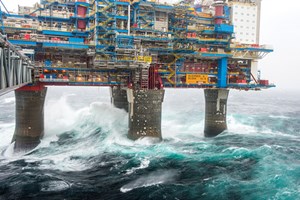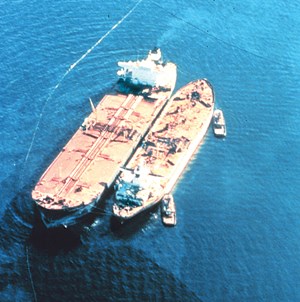Challenges and Setbacks
As well as playing host to two major industry downturns, the period between 1986 and 2000 also saw the upstream industry contend with a number of challenges and also achieve remarkable feats.
Setback with Sleipner A. Today, Norway’s Sleipner field development stands as one of the North Sea’s top gas producers. The development, which is comprised of four installations, processes gas and condensate from Sleipner Øst, Gungne and Sleipner Vest fields. The development also processes hydrocarbons from tie-backs to Sigyn, Volve and Gudrun fields. From 2017, it also will take rich gas from Gina Krog field. However, despite the development’s considerable success, the project initially got off to a rocky start.
Sleipner A was designed as a Condeep type of gravity-based platform, which would sit on the sea floor when fully ballasted. However, the unthinkable happened in August 1991, when the concrete gravity base sank in 200 m of water. The structure had been towed into Gandsfjord—a fjord in Rogaland County, Norway, near Stavanger—where it was to be mated with the topsides. However, as the structure was being lowered into the water, as part of a controlled ballast operation, a design error resulted in a structural failure, which sent the structure to the bottom.

However, despite the setback, in a remarkable testimonial to Nordic efficiency, Norwegian Contractors, the company responsible for the structure, was able to build a replacement in record time. To expedite construction, the replacement hull was constructed more simply. A substantial amount of equipment was removed from the shaft and placed in a riser installation. The riser enabled the field to become an important gas hub in the North Sea, as Statoil was able to route several pipelines from other fields up through it.
Despite the initial setback, the Sleipner A platform (Fig. 1) was towed from Stavanger, via the Ryfylke fjord, on June 7, 1993. And on June 16, the platform was lowered into position. Against all odds, gas deliveries from Sleipner Øst commenced—on schedule—on Oct. 1, 1993.
Piper Alpha. Piper field—a name which would later attain unwanted infamy—was discovered in 1973. This North Sea field, which was developed by Occidental Petroleum’s Piper Alpha platform, began life unremarkably enough, achieving first oil in 1976. However, 12 years later, the platform was the site of a disaster that claimed the lives of 167 people.
The modular platform was constructed by McDermott Engineering, with the four main operating areas separated by firewalls. As part of its design, the most hazardous areas were located away from personnel and command areas. However, this aspect of the design was compromised by the installation of a gas compression module next to the platform control room. The danger was escalated by Occidental’s decision to continue to keep the platform producing throughout major maintenance, instead of shutting it down, as originally planned.
On July 6, 1988, a worker performing routine maintenance removed the pressure safety valve from one of the platform’s two condensate pumps. As the work could not be completed before the shift change, the worker used a hand-tightened blind flange to temporarily seal the pipe, and completed a permit stating that the pump was not operational and shouldn’t be activated. However, the permit wasn’t found by workers on the next shift, and the location of the valve—which was several feet in the air and behind other equipment—negated any chance of it being found by chance.

That night, at 21:45, the gas compression system became blocked by a hydrate build-up, which resulted in the platform’s second condensate pump stopping. When workers, who were still unaware of the missing valve, switched on the first condensate pump minutes later, gas began to leak thorough the hand-tightened blind flange, before igniting and exploding.
The incident initiated a chain reaction of explosions and failures, and 167 people, including two crew members on a nearby standby vessel, lost their lives. There were 61 survivors. A subsequent inquiry into the disaster, by Lord Cullen, made 106 recommendations about how safety in the North Sea could be improved, all of which were accepted by both the government and industry.
Exxon Valdez. While the 2010 Macondo incident in the Gulf of Mexico has come to dominate the upstream industry’s modern psyche, the Exxon Valdez oil spill served as a watershed moment in the 1980s. Prior to Macondo, it was the largest, single oil spill in U.S. coastal waters. According to the National Oceanic and Atmospheric Administration, the tanker (Fig. 2), which ran aground on Bligh Reef in Alaska’s Prince William Sound on March 24, 1989, spilled about 346,000 bbl of oil. The accident embroiled Exxon in years of litigation. ![]()
- Applying ultra-deep LWD resistivity technology successfully in a SAGD operation (May 2019)
- Adoption of wireless intelligent completions advances (May 2019)
- Majors double down as takeaway crunch eases (April 2019)
- What’s new in well logging and formation evaluation (April 2019)
- Qualification of a 20,000-psi subsea BOP: A collaborative approach (February 2019)
- ConocoPhillips’ Greg Leveille sees rapid trajectory of technical advancement continuing (February 2019)


